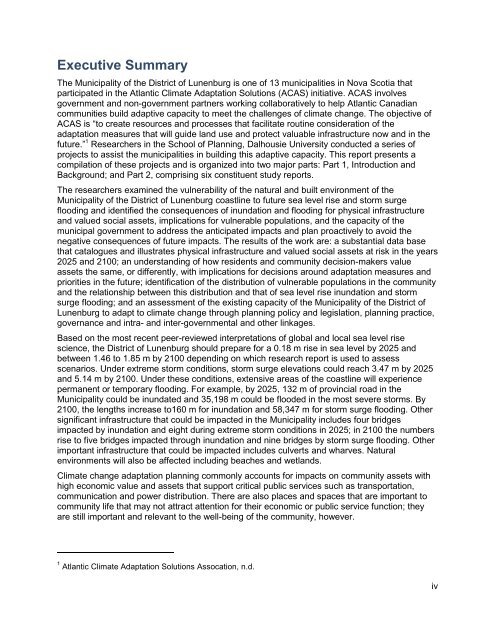Lunenburg Part 1 - Introduction and Background August 30.pdf
Lunenburg Part 1 - Introduction and Background August 30.pdf
Lunenburg Part 1 - Introduction and Background August 30.pdf
You also want an ePaper? Increase the reach of your titles
YUMPU automatically turns print PDFs into web optimized ePapers that Google loves.
Executive Summary<br />
The Municipality of the District of <strong>Lunenburg</strong> is one of 13 municipalities in Nova Scotia that<br />
participated in the Atlantic Climate Adaptation Solutions (ACAS) initiative. ACAS involves<br />
government <strong>and</strong> non-government partners working collaboratively to help Atlantic Canadian<br />
communities build adaptive capacity to meet the challenges of climate change. The objective of<br />
ACAS is “to create resources <strong>and</strong> processes that facilitate routine consideration of the<br />
adaptation measures that will guide l<strong>and</strong> use <strong>and</strong> protect valuable infrastructure now <strong>and</strong> in the<br />
future.” 1 Researchers in the School of Planning, Dalhousie University conducted a series of<br />
projects to assist the municipalities in building this adaptive capacity. This report presents a<br />
compilation of these projects <strong>and</strong> is organized into two major parts: <strong>Part</strong> 1, <strong>Introduction</strong> <strong>and</strong><br />
<strong>Background</strong>; <strong>and</strong> <strong>Part</strong> 2, comprising six constituent study reports.<br />
The researchers examined the vulnerability of the natural <strong>and</strong> built environment of the<br />
Municipality of the District of <strong>Lunenburg</strong> coastline to future sea level rise <strong>and</strong> storm surge<br />
flooding <strong>and</strong> identified the consequences of inundation <strong>and</strong> flooding for physical infrastructure<br />
<strong>and</strong> valued social assets, implications for vulnerable populations, <strong>and</strong> the capacity of the<br />
municipal government to address the anticipated impacts <strong>and</strong> plan proactively to avoid the<br />
negative consequences of future impacts. The results of the work are: a substantial data base<br />
that catalogues <strong>and</strong> illustrates physical infrastructure <strong>and</strong> valued social assets at risk in the years<br />
2025 <strong>and</strong> 2100; an underst<strong>and</strong>ing of how residents <strong>and</strong> community decision-makers value<br />
assets the same, or differently, with implications for decisions around adaptation measures <strong>and</strong><br />
priorities in the future; identification of the distribution of vulnerable populations in the community<br />
<strong>and</strong> the relationship between this distribution <strong>and</strong> that of sea level rise inundation <strong>and</strong> storm<br />
surge flooding; <strong>and</strong> an assessment of the existing capacity of the Municipality of the District of<br />
<strong>Lunenburg</strong> to adapt to climate change through planning policy <strong>and</strong> legislation, planning practice,<br />
governance <strong>and</strong> intra- <strong>and</strong> inter-governmental <strong>and</strong> other linkages.<br />
Based on the most recent peer-reviewed interpretations of global <strong>and</strong> local sea level rise<br />
science, the District of <strong>Lunenburg</strong> should prepare for a 0.18 m rise in sea level by 2025 <strong>and</strong><br />
between 1.46 to 1.85 m by 2100 depending on which research report is used to assess<br />
scenarios. Under extreme storm conditions, storm surge elevations could reach 3.47 m by 2025<br />
<strong>and</strong> 5.14 m by 2100. Under these conditions, extensive areas of the coastline will experience<br />
permanent or temporary flooding. For example, by 2025, 132 m of provincial road in the<br />
Municipality could be inundated <strong>and</strong> 35,198 m could be flooded in the most severe storms. By<br />
2100, the lengths increase to160 m for inundation <strong>and</strong> 58,347 m for storm surge flooding. Other<br />
significant infrastructure that could be impacted in the Municipality includes four bridges<br />
impacted by inundation <strong>and</strong> eight during extreme storm conditions in 2025; in 2100 the numbers<br />
rise to five bridges impacted through inundation <strong>and</strong> nine bridges by storm surge flooding. Other<br />
important infrastructure that could be impacted includes culverts <strong>and</strong> wharves. Natural<br />
environments will also be affected including beaches <strong>and</strong> wetl<strong>and</strong>s.<br />
Climate change adaptation planning commonly accounts for impacts on community assets with<br />
high economic value <strong>and</strong> assets that support critical public services such as transportation,<br />
communication <strong>and</strong> power distribution. There are also places <strong>and</strong> spaces that are important to<br />
community life that may not attract attention for their economic or public service function; they<br />
are still important <strong>and</strong> relevant to the well-being of the community, however.<br />
1 Atlantic Climate Adaptation Solutions Assocation, n.d.<br />
iv














